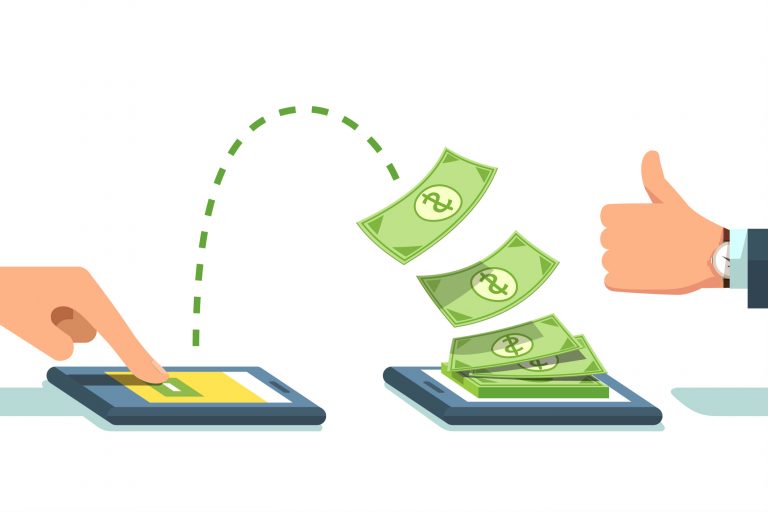There are many options available for sending and receiving money these days. However, the days of mailing cash or even checks to cover our everyday expenses are long gone.

After all, when was the last time you mailed a birthday card with actual bills in it? Alternatively, one of the most common ways to send money now is electronically through the Automated Clearing House network.
This technology underlies many payment types we use every day, such as PayPal when purchasing goods online or receiving government benefits like Social Security. You can also initiate ACH transfers to send and receive money through your bank or credit union.
You also might wonder what the difference is between an ACH and a wire transfer. We’ll walk you through the pros and cons of each so you can figure out which is the best to use.
You’ll also learn restrictions on ACH transfers and how to keep your money safe during these transactions. An ACH transfer is a great way to send and receive money, but it’s helpful to know a few pertinent details before you get started.
What are ACH transfers?
Automated Clearing House (ACH) transfers are a popular method of transferring money from one bank account to another. They are part of a robust ACH network managed by the National Automated Clearing House Association (NACHA), making them a trustworthy solution for moving money electronically.
There are two types of ACH transfers: ACH debit and ACH credit. ACH debit occurs when funds are pulled from a bank account, like when making bill payments. Conversely, ACH credit is when funds are pushed into a bank account, like when you receive payments such as direct deposits from an employer.
Automated Clearing House (ACH) is responsible for electronically transferring funds between banks. In addition, many third parties like PayPal and government benefits such as Social Security use the ACH network. You may also be familiar with ACH payments such as automatic bill payments, direct deposits, and transfers between accounts.
Other transactions that can be processed through the ACH network, include direct debits, direct payments, eChecks, and electronic funds transfers (EFTs).
How ACH Transfers Work
For an ACH transfer, the transaction process begins with the Originating Depository Financial Institution (ODFI), which could be a bank or credit union where the money is coming from. The ODFI sends ACH transactions to the ACH network, which are then received by the Receiving Depository Financial Institution (RDFI), the bank where the money is being sent.
How long do ACH transfers take?
ACH credit transactions usually take no longer than one to three business days to settle. However, advancements in technology and banking regulations have now allowed for same day ACH transfers in many cases.
ACH credits must be processed within one to two business days. These rules are set by NACHA, the trade group that manages the network.
ACH debit transactions must be processed within a single business day. However, the RDFI may institute a holding period. So, it could take up to a few days to finalize the ACH transfer.
New regulations are moving towards same-day delivery by requiring three network processing times each day, rather than just one. However, some banks and credit unions may charge an extra fee for this premium service.
Benefits of ACH Transfers
ACH transfers have numerous advantages over traditional wire transfers and check payments.
For starters, they’re convenient. You can set up recurring payments for monthly bills, automate direct payments to contractors or vendors, and receive direct deposits into your bank accounts.
They’re also cost-effective. While wire transfers often come with fees, ACH transfers are typically free or come with minimal charges from banks and credit unions.
Safety is another benefit of ACH transfers. By reducing the need for physical checks, you decrease the chances of fraud. The automated clearing house ACH network also has strong protocols in place to protect against unauthorized transactions.
Potential Limitations and Downsides of ACH Transfers
Despite the benefits of ACH transfers, it’s also important to understand potential limitations. First, you may encounter daily or monthly limits to the amount you are allowed to transfer from each account.
If this might impact you regularly, you should check with your bank on their specific policy before relying on that account. Next, federal law limits the number of monthly transactions to six a month from savings accounts.
If you surpass this limit, you can be charged a fee, so keep track of your transfer habits for each account. You should also monitor the money in your account.
Processing delays can also occur. While many transfers are seamless, factors such as weekends, holidays, and the policies of the individual financial institution can impact timing.
Reversing an ACH transaction can also be difficult. Once an ACH payment has been processed, it generally cannot be reversed unless in the case of an error or fraud.
Finally, insufficient funds in a bank account can lead to returned ACH transactions and potential fees. It’s essential to manage your bank account details closely to avoid such issues.
What’s the difference between an ACH transfer and a wire transfer?
If an ACH transfer sounds a lot like a wire transfer, you’re right: they do share some similarities. However, there are also some stark differences to consider before choosing which one to use.
Most notable is the price difference. ACH transfers are usually free to receive and typically cost less than a dollar to send or could even be free (of course, always check with your bank for specific charges).
Costs
Wire transfers typically cost between $10 and $35 for domestic transfers and up to $50 for international transfers.
Time
On the flip side, ACH payments take extra time to process, while wire transfers are speedy.
A wire in the United States, for example, can be received within hours and often even within minutes of the funds being sent.
International Transfers
International wire transfers may take a bit more time than domestic ones. But, you probably won’t be permitted to send ACH payments outside the country.
So if you need to send money abroad, a wire transfer is your best bet. Despite the additional cost, it’s still a fast and safe option to use for this purpose.
Time for Funds to Clear
With a wire, the funds are cleared before the money appears in the recipient’s account. The process isn’t entirely automated because a bank employee is needed to finalize the funding, but it’s still a quick process overall.
ACH transfers are handled in batches as they come in, which is why there’s a slower turnaround time. These two types of transfers differ significantly, so it’s important to analyze your priorities before picking which one to use.
ACH vs. Wire Transfer
Choosing between an ACH and a wire transfer comes down to two variables: cost versus speed. If you need to make a large, one-time transfer, especially if it must be done in a hurry, a wire is probably the most suitable choice.
A common example would be making a down payment on a piece of real estate. A wire transfer provides quick funding that’s validated before being accepted, so the bank is assured that the transfer is fully complete.
Wire transfers are also ideal for international transactions. Whether you have family living abroad or a college-age student studying in a foreign country, a wire can get them the money they need quickly. Yes, a wire is pricier. But, you certainly get a lot of value for the speed of use if you’re in a time-sensitive situation.
But for regular, small transfers that aren’t incredibly time-sensitive, you can stick with ACH in most instances. Your employer could set up ACH direct deposits, which are free of charge to you.
It’s also generally free to sign up for automatic bill pay, whether through your bank or directly with each company you owe. ACH transfers are also easy (and usually free) when you need to transfer money to and from different bank accounts.
So if you have a high-yield savings account with one bank and a checking account with another, you can easily transfer funds between them. It may take a few days, but the process is simple. First, evaluate your needs for each transaction to figure out which one is best for you.
How to Set Up an ACH Transfer
When you decide to send or receive an ACH payment, the process is fairly simple. To send one, you’ll need to provide the name of the bank you’re sending money to, the relevant account number, and the ABA routing number.
You can find the account number and routing number at the bottom of the recipient’s check. There will be a string of numbers in the lower left-hand corner that contains this information. The first nine digits are the routing number, while the next 12 digits are the account number.
The final four numbers are the check number, which isn’t relevant for an ACH transaction. Once you have this information, you can initiate the transfer with your bank.
Suppose you need to send money to financial institutions instead of an individual. In that case, you can initiate automatic transfers through your bank, as long as the recipient is eligible to receive them.
Receiving an ACH Transfer
To receive an ACH transfer, you’ll need to provide the sender with the same information as above: your bank account number and routing number. Some places, such as your employer setting up direct deposit, may request a voided check to retrieve that information directly.
Another option is to use a third party like PayPal. It’s quick and easy, although you may experience processing times between three and five days when you transfer funds to your bank.
Sending money to friends and family in the U.S. is free. However, if you want to send money abroad, it costs a percentage of the amount you’re sending. It varies based on the recipient’s country and how the transfer is funded.
PayPal charges 2.9% of the transaction amount to receive payment for goods or services, plus $0.30. You can compare the costs of similar services, but these fees are fairly standard.
Are ACH transactions safe?
Generally speaking, ACH transactions are safe and secure to use. Overall, ACH fraud is extremely rare. However, to receive funds, you do have to turn over your bank account numbers, which is sensitive information.
Make sure you trust the recipient; otherwise, they could potentially use your bank information to withdraw funds from your account. If you encounter a fraudulent withdrawal, be prepared to pay a fee. You’re liable for $50 if you report the incident within two days and $500 if you report it within 60 days.
So, it’s important to check your bank account regularly to make sure all of your debits are accurate. If you notice anything out of the ordinary, report it to your bank immediately to prevent any major liability. After all, you don’t want to be out $500 because of ACH fraud!
Canceling an ACH Transfer
A final issue to consider when receiving ACH payments is that, in limited circumstances, the sender can actually reverse the transaction.
Check with your bank about how they handle this process because it differs from place to place. Though rare, this could happen, for instance, if your employer deposits the wrong amount into your bank account.
Rather than asking you to return the funds manually, they could simply reverse the funds to come back to them.
If there aren’t any mistakes or you’re not a victim of fraud, you typically don’t need to worry about this happening with your ACH credits. Still, it’s something to be aware of, particularly if you receive direct deposits from your employer.




